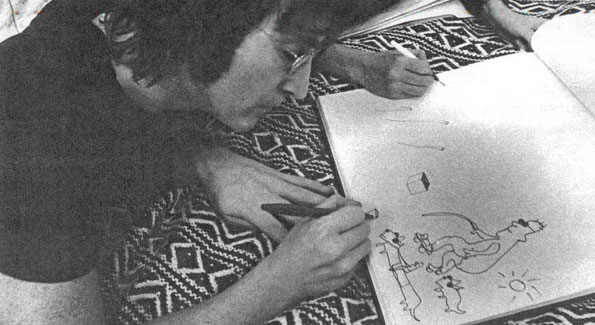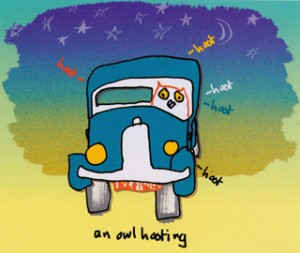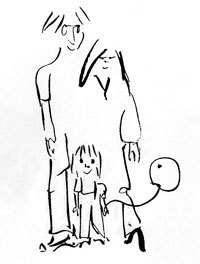Since her husband John Lennon’s death thirty years ago, Yoko Ono has been vigilant with another passion that keeps her close to her soulmate: John’s art.
In 1968, avant-garde artist Yoko Ono brought the new love of her life, Beatle John Lennon, to an art show she was a part of in Coventry, England.
It was an experience that would come to perfectly symbolize the spiritual, romantic and artistic bond that would prosper for a dozen years until Lennon’s death in 1980.
“I thought that John should come with me and do something at the show too,” Yoko told me the last time she came through town with John’s artwork. Yoko’s “In My Life” exhibit, presented by her and the Georgetown BID, with pieces for sale and on display, will be at 3307 M Steet in Georgetown May 7th through the 9th.
“John said ‘I want to plant an acorn.’ I thought it was such a beautiful idea: an acorn as sculpture. So I said I would do the same, we will plant two acorns together. One was planted in the East, because I come from the East, and John planted one in the West. But the idea that ‘East is East, and West is West, the two shall not meet’ was turned around into ‘East and West are together.’ John said ‘Yes, mine is in the West, but it’s right next to you.’ We thought that was very beautiful, that we had made a revolution in a sense, that we changed physical distance with our love.”
During their time together, Yoko would prove to not only be the true love of Lennon’s life, but often his creative collaborator on everything from music to controversial protests to vanguard forms of media. But perhaps her most important influence on Lennon was her passionate encouragement of his growth as an artist, both when he was alive and posthumously. The road to acceptance for the iconic couple however, in art or anything else, was not an easy one.
“I have been given so much grief for my expression, in general, from the beginning,” Ono told me. “But it seems that later, people started to understand what I am doing, and I’m very happy about that. As far as John’s art, some would say, “the musician’s trying to be an artist’, but the professional artists and the art students, they’ve been tremendously impressed with John’s work over the years. John’s style is more or less the kind of style Picasso had in his later years, but John was not copying anyone. John had his own style.”
A profound chapter in Lennon’s art career are his “Real Love – The Drawings For Sean” pieces, which illustrate the intense love Lennon had for he and Ono’s son, Sean. Lennon’s difficult childhood fueled his deep desire to make life for Sean much different from the one he had.
“John had a terrible childhood,” Ono continued. “His father was not around, so when John became a father with Sean, he was just so happy, he was so loving to Sean. Everything he did with Sean, including the drawings, was something that he cherished.”
And if her husband were still living, what would he and Yoko be collaborating on these days?
“I just think that we’d be going crazy doing the same things we used to do.”
JOHN AND HIS SECOND PASSION
“Art came first in my life”, John Lennon once said. “I started to make money with music and the guitar, but art always came first in my life.”
It’s lucky for the rest of us that no one took a real interest in John Lennon’s early art career. If someone had, the music world, even the world in general, might be different today.
But during the time he was living as one of the world’s most famous musicians, John Lennon did manage to add “artist” to his genius’ resume, and today his work can be seen in museums and private collections worldwide.
Lennon’s art interests began during his schoolboy days in Liverpool, even pre-dating his musical ones. “We have incredible drawings in the archives of John drawing Normans and Saxons, and it says ‘John Lennon, age nine and a half ’ or ‘John Lennon, age ten’ “, said Lynne Clifford, who worked with Yoko Ono for decades as director of Bag One Arts, Yoko’s company dedicated to preserving John’s art legacy.
“From 1957 to 1960, John was formally trained at the Liverpool Art Institute, one of the best art schools in the UK. He was able to get into the school not based on his high marks, he wasn’t a great student, but because one of his professors recognized his genius. ”
In the years after art school, Lennon joined a band, quit a band, and became a music legend. But he kept drawing, mostly working in quick sketching, and even going to Japan in 1977 to learn the difficult technique of Sumi ink drawing.
Clifford says Lennon’s style has been characterized by art critics as “being situated between the worlds of free drawing, caricature and illustration, with a keen sense of observation, wit and irony.” But above all, it was simply another way Lennon communicated with people.
“He was a master of communication. He communicated though his art, through his music, though his poetry. He reaches out with his art. One of the things I find amazing about his art is how it touches men’s psyches. It’s usually the woman who purchases the art for the home, but about 75% of the sales that we do are to men. They look at John’s art and it’s a visceral reaction, they put themselves right into the picture, and they get it.”
Clifford feels that Yoko has been very brave to let the world see such intimate expressions of John’s love for his family.
“Often when Yoko and I are sitting together and we’re taking the artwork out of the archive, she’ll start crying, because she remembers what he was doing when he was drawing them. Yoko was his muse. He drew her over and over again. When Sean was born, he incorporated that into his work. It’s all a real intimate, autobiographical portrait of what their lives together were like.”
Clifford recalls a quote from Yoko that perfectly sums up Lennon’s “other” career. “In his lifetime, John Lennon ‘the artist’ remained an outsider to the art world, largely because of his fame as a Beatle. In hindsight that was very fortunate, because it allowed his works to maintain their purity, with his unique style remaining untouched by the trends.”







